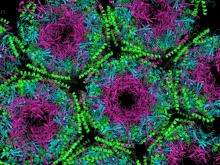Sticky antibodies block prion disease

(PhysOrg.com) -- Antibodies that stick to a brain prion protein called PrP could be the key to treating prion diseases like variant CJD and preventing people accidentally exposed to prions from going on to develop the fatal brain disease. Using a precise visualisation technique, called X-ray crystallography, carried out at the Synchrotron Radiation Source (SRS) at the Science and Technology Facilities Councils (STFC) Daresbury Laboratory in Cheshire, scientists have identified an antibody that has the best ability to bind to PrP in the brain. Experiments using cells in the laboratory and in mice have suggested it could stop prion infection in its tracks.
Prion infection depends on conversion of naturally occurring PrP into a corrupted form called PrPSc that has a different shape. This change in shape is critical for disease progression and happens when PrP comes into contact with infectious prions. PrPSc builds up causing the death of brain cells and other symptoms of prion disease.
Past research has shown that the conversion process can be interrupted by immunisation with antibodies designed to stick to PrP. This study reveals that the ability of an antibody to reduce prion infection is dependent on how well it binds to normal PrP. Whether or not the antibody sticks to PrPSc too is irrelevant. A monoclonal (designed specifically to match one target) antibody called ICSM18 has been found to be the most effective.
Professor John Collinge, Director of the MRC (Medical Research Council) Prion Unit, explained the background: ''Naturally occurring prion protein is an established therapeutic target for prion disease: studies at the MRC Prion Unit have demonstrated that when we stop brain cells of infected mice making PrP, onset of disease is prevented and early damage to the brain recovers. In this research we have prevented normal PrP from getting drawn into this process by binding antibodies onto them. We have also shown that the monoclonal antibody ICSM18 has the highest therapeutic potential in cell and mouse based studies. Whether or not it will have the same impact in people who have vCJD or other prion diseases is yet to be established, but we are trying to make human versions of these antibodies for future trial in people.''
By visualising the interaction between antibody and prion protein at a molecular level using X-ray crystallography, the researchers at Liverpool's Molecular Biophysics group were able to see exactly which parts of the two proteins stick together.
Interestingly, they found that the point where the two prion proteins come together is exactly where a key building block of the protein resides at position 129. It has been known for some years, from earlier work by MRC Prion Unit scientists, that the amino acid at position 129 has a radical effect on an individual's susceptibility to prion disease. There are two common forms of prion protein present in the population with either the amino acid methionine (M) or valine (V) at position 129.
Around a third of the UK population have two M copies of the prion gene, this means they are "MM". Around 10% of people are "VV" and the remainder have the commonest "MV" genetic type. This genetic variation is one of the strongest causes of genetic susceptibility known in any human disease and every patient who has developed vCJD has been MM. Those who have the MV genotype are partially protected against developing these diseases. The crystallographic structure, that allowed the research team to look inside the molecule at atomic details, explains why this single building block is so important in determining a person's risk of developing prion disease, as the M and V proteins interact less readily that two M or two V amino acids.
The finding is the result of collaboration between molecular biologists at the Medical Research Council Prion Unit, University College London, and biophysicists at the University of Liverpool. The results are published in the journal PNAS, Proceedings of the National Academy of Sciences.
Commenting on the significance of the study findings lead partner for structural studies, Professor Samar Hasnain, Max Perutz Professor of Molecular Biophysics at the University of Liverpool said: ''The key to this research has been our ability to visualise the exact crystal structure of the prion protein when it is bound to the most effective monoclonal antibody. The results announced today are a great example of research crossing disciplines to share the skills of molecular biologists and biophysicists to solve problems associated with human disease.''
Provided by Science and Technology Facilities Council

















